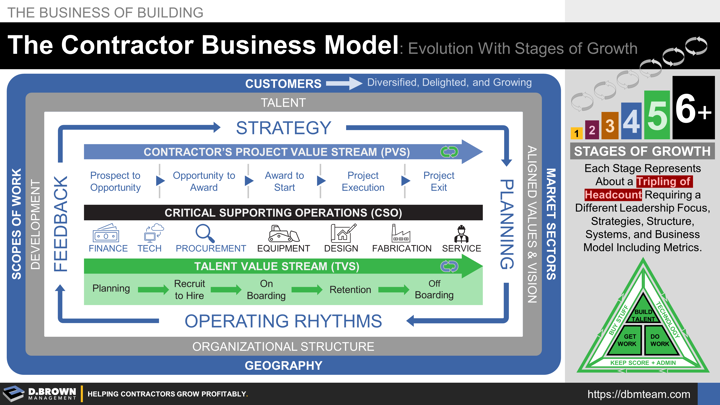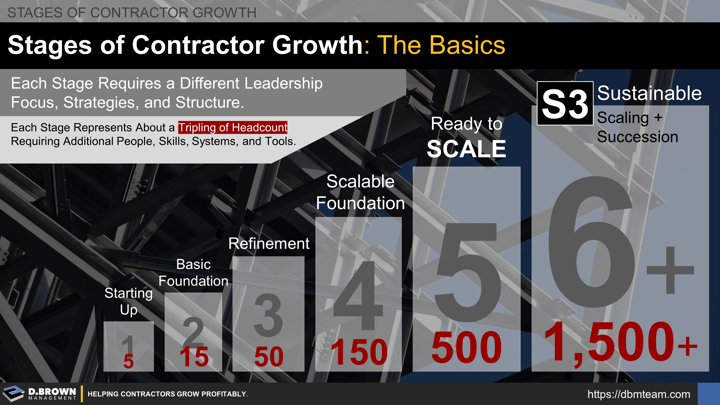Every construction contracting business has six basic components that evolve with each stage of growth.
- Customers we build for.
- Talent - the people that make it happen.
- Project Value Stream (PVS): Every step required to win a project and get it built.
- Critical Supporting Operations (CSO): Every step required to support the work, starting with payroll and the ability to buy materials.
- Talent Value Stream (TVS): Every step required to recruit, train, develop, and retain the talent required to build work for the customer both today and tomorrow.
- Strategy that connects everything together outside and inside the company. This strategy starts simple for a Stage 1 contractor and evolves with each stage of growth including the levels and integration of the strategic decisions.
All models are wrong, but some are useful.
The purpose of this model is to provide a visual representation of your business both as it is currently and to study the possibilities for what it will look like at the next stage of growth. Below is a simplified typical view of the evolution of the business model at different stages:
STAGE 1: Finding a customer that will pay you to build a project. Customer and Project Execution IS the business model.
STAGE 2: Finding talent to support growth while getting some of your supporting operations like accounting, technology, and purchasing started at a basic level.
STAGE 3: Expanding how you think about customers to keep them diversified, delighted, and growing, including dabbling in some work that is out of the area (Geography). You will also be focused more on the work required before a project starts to set it up for success (Award-to-Start) and what it takes to exit the project quickly which accelerates cash flow and customer satisfaction (Project Exit).
STAGE 4: Expanding and refining the Market Sectors you compete in which is typically driven at this stage by opportunities presenting themselves through your reputation and growth.
- This drives more attention to managing these opportunities more rigorously (Opportunity-to-Award).
- This accelerates growth starting to drive attention to the most tangible part of the Talent Value Stream (TVS) which is the Recruit-to-Hire phase.
- More Critical Supporting Operations (CSO) are being dabbled in to help with Project Execution possibly including Equipment, Design, Fabrication, or Service. Some of these are working better than others and none have reached their full potential.
- Planning is beginning but in very early stages for modeling the business around revenue, projects, budgets, and major resources.
STAGE 5: Strategic Decisions about where to play and how to win including what to say "NO" to starts to drive lots of internal decisions, including looking at different Scopes of Work that could be delivered to the same customers. This may involve strategic partnering with other contractors, acquisitions, mergers, or building of new capabilities.
- Business Development becomes a more structured process involving a wider range of people and systems (Prospect-to-Opportunity).
- Critical Supporting Operations (CSO) are becoming fully aligned with the Strategic Decisions at all levels, providing significant growth capacity and competitive advantages.
- This drives a very different Organizational Structure than what was required in prior stages of growth, including some different behaviors to be successful at this stage of growth (Aligned Values and Vision). As an example, Stage 1 requires a heavier focus on individual initiative and creativity to deliver outcomes while Stage 5 requires a heavier focus on collaboration and standards to deliver consistent and scalable outcomes.
- There is now more focus on the next couple phases of the Talent Value Stream (TVS) including "On Boarding," which starts with the job offer through their first day and until they are consistently performing to the standards for the role they were hired for.
- Retention is a critical focus with the changes to some of the strategies, structure, and behavioral norms from prior stages of growth.
- At this stage of growth, it is critical to focus not just on ensuring people are trained and competent in their current job role, but that they are being Developed for future roles. Succession at all levels is crucial at this stage of growth for sustainability.
STAGE 6+: This is heavily about refinement and sustainability. At Stage 5, most of the basic parts and pieces are in place.
- The key evolution here is a lot more structure and systems around Strategy, Planning, and Development, including routine Operating Rhythms and Feedback systems.
- This Planning at the business level flows into the Talent Value Stream (TVS) with a focus on Planning for talent needs well into the future, including models for career growth, turnover (regrettable and non-regrettable / voluntary and non-voluntary), and retirement.
- This flows into a focus on Off-Boarding someone out of a role whether due to promotion, retirement, or for some other reason. With the shortage of talent, being able to extend the value-add from a contractor's highly experienced talent by a few years is critical.
The quantity of people and functions within the Contractor Business Model grow in a linear way as a contractor navigates the Stages of Growth. The relationships grow exponentially and that is where the majority of the problems typically occur.
Dr. Russell Ackoff (Worked with Edwards Deming)
"A system is never the sum of its parts, it’s the product of their interaction.
The performance of a system doesn’t depend on how the parts perform taken separately, it depends on how they perform together. How they interact, rather than on how they act, taken separately. Therefore, when you improve the performance of a part of a system taken separately, you can destroy the system."
Action Items
- Build a basic visual representation of your business today. You can use this model as a starting point. Contact us for a copy of this in PowerPoint that you can adjust for your situation.
- Where are your Top 3 bottlenecks as you look at your model? These are the areas of the business that are most impacting your ability to grow profitably.
- Is the bottleneck one of capability (can do the work), consistency (does the work every time the same), or capacity (can do enough of the work).
- If you could only focus on one of those bottlenecks, which one would it be and why? This is the one area that if improved, would most impact the amount of projects and profit flowing through your business.


